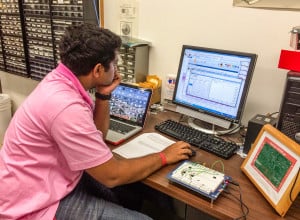The electrical engineering department implemented new curriculum changes and introduced several extracurricular activities for its students this year. The overhaul was intended to give the students a greater degree of control and flexibility over their major.

Abbas El Gamal, chair of the electrical engineering department, says that the old curriculum required students to go through a series of prerequisite courses, such as those in math and physics, without being able to get into application until deeper in the program.
One of the first changes considered was the creation of a broader set of requirements along with a lower unit requirement.
Approximately a year ago, during a faculty retreat, professors who lectured the core classes had a discussion about the emphasis in introducing engineering applications. As a result, the faculty decided to create six new classes focused more on the applications of the materials taught in the classroom. Among these six courses are “ENGR 40M: An Intro to Making: What is EE,” which allows students to build kits that they then get to keep and “EE65: Modern Physics for Engineers.”
Alex Omid-Zohoor ’10 M.S. ’10, an electrical engineering Ph.D. student and undergraduate advising TA, expressed excitement about the changes, which he expects will help students realize whether they are a fit for the EE degree.
“Getting students excited about the things that they’re going to be able to do with an EE degree is I think a great introduction to the major,” Omid-Zohoor said. “Letting students find out what they love to do before they do it I think is the way to get students to do their best work.”
These changes, which will mainly affect declared freshmen and sophomores, give juniors and seniors the choice to follow either the old or the new curriculum requirements. To ease the process, Omid-Zohoor created an online tool to allow students to check their academic plans against curriculum requirements.
Modeling after the breadth of interest among electrical engineering graduate students, El Gamal hopes to widen the scope of interest for undergraduate students by placing an emphasis on hands-on work and on research experience for undergraduates’ summer programs.
In addition to the curriculum change, the electrical engineering department has aided the creation of a new student club for electrical engineering undergraduates called Fuse.
“[The EE students] are taking the same courses, we have the same life experiences, but we’re kind of fragmented and we don’t necessary talk to each other outside of school,” said Fuse co-founder Maisy Wieman ’14, M.S. ’15, a co-terminal student in the engineering department.
Weiman said that the club is designed to bring students together, give younger students advice and protects students from becoming overwhelmed, similar to the protective purpose served by a fuse in a circuit.
Many engineering students, including Omid-Zohoor, hope that new students will no longer view electrical engineering as a major that is restrictive and inflexible.
“The goal of EE, I think, is not to define itself in how rigorous it is, but more in enabling a broad set of applications for interested students – I think new students should find it more accessible, for sure,” Omid-Zohoor said.
This post has been updated to correct two editing errors. In the previous version of this article, quotation were present in the second and eleventh paragraphs when the quotes had in fact been paraphrased. The Daily regrets this error.
